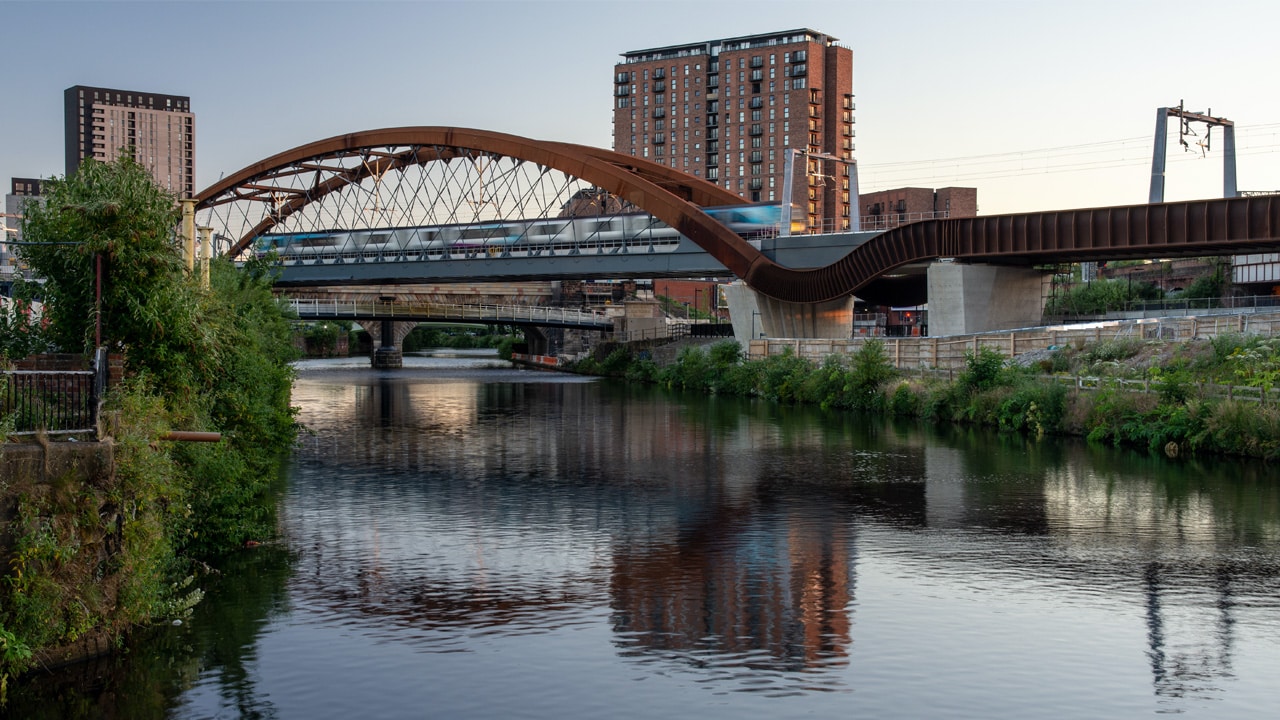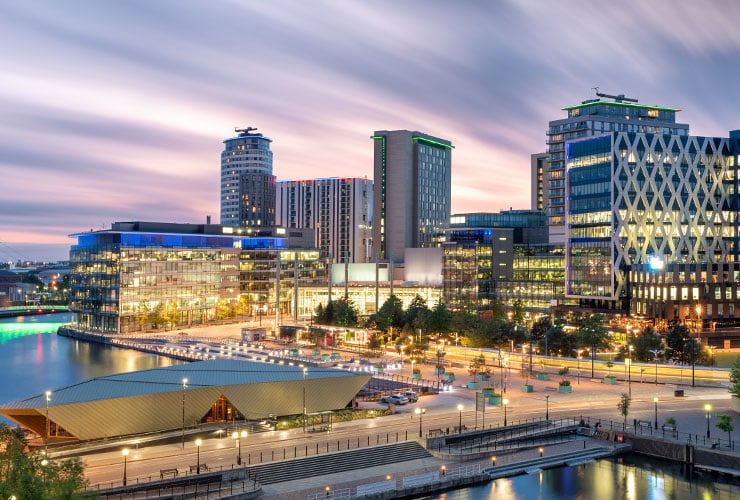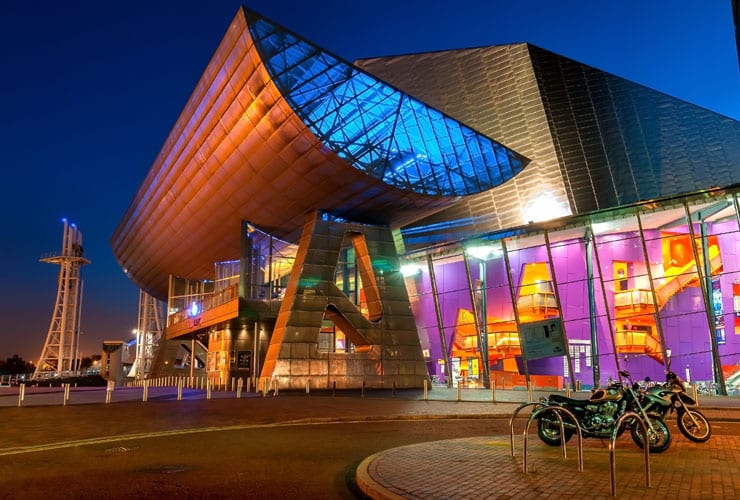Salford Property Investment: Best Buy-to-Let Areas 2025
Salford property investment opportunities are emerging as some of the most promising in Greater Manchester, potentially outperforming Manchester City Centre itself.
With its strategic location west of Manchester, ongoing regeneration projects, and attractive mix of property values and rental yields, Salford for many years has been catching the eye of property investors seeking both capital growth and rental returns.
But has the market reached a peak or are there still some local opportunities.
In this article, we examine the best areas for buy-to-let in Salford, analysing key metrics like sold house price growth, current average asking prices, population growth and even what deposits you might need to get started purchasing buy-to-lets in Salford.
Data updated: February 2025. Next update: April 2025
Salford Buy-to-Let Market Overview 2025
Average yields range from 4.0% to 6.5%, with property prices spanning £191,623 to £337,582. Top performing areas include Pendleton (M6) for yields (6.5%) and Worsley (M28) for capital growth. Areas near Media City and the University show strongest rental demand, with average monthly rents between £893-£1,348.
Contents
- Best areas for buy-to-let in Salford
- Why invest in Salford?
- When was the last house price crash in Salford
- Average sold house prices in Salford by property types
- House prices in Salford: For sale asking prices (£)
- Price per square foot in Salford (£)
- House price growth in Salford (%)
- Rental prices in Salford (£)
- Gross rental yields in Salford (%)
- Is Salford rent high?
- Are Salford house prices high?
- How much deposit to buy a house in Salford?
- Salford population growth
- Salford landlord licensing
- How to invest in buy-to-let in Salford

-
by Robert Jones, Founder of Property Investments UK
With two decades in UK property, Rob has been investing in buy-to-let since 2005, and uses property data to develop tools for property market analysis.

Property Data Sources
Our location guide relies on diverse, authoritative datasets including:
- HM Land Registry UK House Price Index
- Ministry of Housing, Communities and Local Government
- Ordnance Survey Data Hub
- Propertydata.co.uk
We update our property data quarterly to ensure accuracy. Last update: February 2025. Next update: April 2025. All data is presented as provided by our sources without adjustments or amendments.
Best Areas for Buy-to-Let in Salford
Highlights
Salford, a key part of Greater Manchester and home to BBC Studios and Media City UK, offers compelling investment property opportunities with its mix of regeneration areas, established suburbs, and luxury new developments. The city's transformation, particularly around Salford Quays and the University area has been remarkable.
Average house prices £
- High end: M28 (Worsley) leads the market at £337,582, while M29 (Tyldesley) follows at £274,456, representing Salford's premium suburban locations.
- Mid-range: Areas like M3 (Salford Central) at £253,642 and M6 (Pendleton) at £249,098 offer good value with strong rental potential.
- More affordable: Areas like M38 (Little Hulton) at £191,623 and M5 (Ordsall) at £235,235 represent more accessible entry points to the market.
Average cost of rents per week £
- High end: M6 (Pendleton) achieves the highest rents at £311 per week, followed by M7 (Higher Broughton) at £294 per week.
- Mid-range: M3 (Salford Central) sees £284 per week, while M50 (Salford Quays) achieves £278 per week.
- More affordable: M44 (Eccles) shows £206 per week, while M29 (Tyldesley) averages £228 per week.
Average buy-to-let rental yields %
- High yield: M6 (Pendleton) leads with 6.50%, followed by M38 (Little Hulton) and M5 (Ordsall) both offering strong yields at 6.20%.
- Mid-range: M50 (Salford Quays) and M3 (Salford Central) both offer solid yields around 5.80-6.00%.
- Lower yield: Premium areas show lower yields, with M28 (Worsley) at 4.00% due to higher purchase prices.
Salford's property market benefits from three key drivers: its proximity to Manchester city centre, the ongoing success of MediaCityUK which continues to attract media professionals and creative businesses, and the University of Salford's significant student population.
The highest property yields currently emerge from Pendleton (M6), where investors achieve attractive 6.5% yields through strong rental demand and relatively moderate property prices of £249,098. Nearby Little Hulton (M38) and Ordsall (M5) both deliver compelling 6.2% yields, benefiting from consistent tenant demand and accessible purchase prices.
Premium areas like Worsley (M28) and Tyldesley (M29) achieve the highest property values at £337,582 and £274,456 respectively. These established suburbs attract families and professionals, though yields are more modest at 4.0-4.3%.
For value-focused investors, areas like Little Hulton (M38) and Ordsall (M5) present interesting opportunities. With average prices at £191,623 and £235,235 respectively, these locations deliver strong yields while offering potential for capital growth through ongoing regeneration initiatives.
Salford Quays (M50) and Salford Central (M3) represent the city's transformation, with good yields of 6.0% and 5.8% respectively. These areas particularly appeal to investors targeting young professionals and those working in Media City UK or Manchester city centre.
Why Invest in Salford?
So is it worth investing in Salford property? For buy-to-let landlord, Salford has great transport connections, making it a convenient place to live and attracting high tenant demand with those who work anywhere in Manchester and throughout north-west England.
Salford has road connections using the A6, A580, M602 and M60 and railway stations at Salford Central, Salford Crescent and Eccles. Parts of Salford are also connected to Greater Manchester’s Metrolink tram network, with Salford Quays a great location for commuters.
Salford’s main industries are similar to the rest of Greater Manchester. They include transport and logistics, light manufacturing, public services, financial and business services and the media and digital industries. Large employers in Salford itself include the BBC (with around 3,200 staff across 26 departments), Salford Royal Hospital and the University of Salford. Nearby Trafford Park, one of Europe’s largest industrial estates, and the Trafford Centre shopping centre provide around 35,000 jobs.
Salford Quays is also home to the Lowry Theatre, Imperial War Museum and the ITV Coronation Street set.
Salford is a large student city. The University of Salford has around 20,000 students. It has a main campus which is centred on the Peel Park area and another campus at Media City.
There is purpose-built student accommodation and a large number of student houses of multiple occupation all over Salford but locations within easy walking distance of the university campuses are generally most popular for student lettings.
Salford is one of the main housing markets for buy-to-let landlords in Greater Manchester, with other cities and towns across the region showing strong real estate markets including Stockport, Preston, Liverpool and Warrington.
Salford Buy-to-Let Market Analysis 2025
When was the last house price crash in Salford?
House price trends vary across Salford postcode districts with some areas experiencing faster growth than others. However, the overall trend for house prices in Salford has been upward over the long term.
The last significant property price crash in Salford occurred during the global financial crisis of 2008-2010, which happened after a significant period of growth between 2000 - 2007. Since then, despite some fluctuations, the market has generally shown resilience and recovery with an upward trend to 2022.
2022 to 2024 there has been a downward trend of house prices for apartments and terrace houses. Potential due to the market becoming too hot, with lots of 19th-century terrace houses seeing a large boom time in the decade previous as lots of investors were buying up available housing and converting these terraces to invest in student HMOs (houses of multiple occupation) to fulfil high local tenant demand for affordable housing near to Salford University.
Interesting in this same period, although apartments and terrace houses have reduced in average market prices in the past two years, detached houses and semi-detached houses have actually maintained there value, as Salford continues to offer affordable larger properties for homeowners and buy-to-let investors, in easy commuting distance with trams and a large motorway network to a variety of employment hubs, compared to nearby Manchester, Stockport and Cheshire which have higher average houses prices for the same property types.
Average Sold House Prices in Salford by Property Types
The latest sold house price index by the land registry, Nov 2024 (it is always a couple of months behind reporting it's datasets), shows the following average house prices across the Salford local authority area.
Salford (local authority area)
- All property types - £248,819
- Flats and maisonettes - £194,613
- Terrace houses - £225,521
- Semi-detached houses - £297,443
- Detached houses - £445,235
Salford sold house prices are close too but slightly behind nearby Manchester sold house prices.

Property Data Sources
Our location guide relies on diverse, authoritative datasets including:
- HM Land Registry UK House Price Index
- Ministry of Housing, Communities and Local Government
- Ordnance Survey Data Hub
- Propertydata.co.uk
We update our property data quarterly to ensure accuracy. Last update: February 2025. Next update: April 2025. All data is presented as provided by our sources without adjustments or amendments.
House Prices in Salford: For Sale Asking Prices (£)
Updated February 2025
The data represents the average asking prices of properties currently listed for sale in Salford.
| Rank | Area | Average House Price |
|---|---|---|
| 1 | M28 (Worsley) | £337,582 |
| 2 | M29 (Tyldesley) | £274,456 |
| 3 | M7 (Higher Broughton) | £263,104 |
| 4 | M27 (Swinton) | £262,588 |
| 5 | M3 (Salford Central) | £253,642 |
| 6 | M6 (Pendleton) | £249,098 |
| 7 | M44 (Eccles) | £246,249 |
| 8 | M30 (Eccles) | £245,949 |
| 9 | M50 (Salford Quays) | £240,656 |
| 10 | M5 (Ordsall) | £235,235 |
| 11 | M17 (Trafford Park) | £234,893 |
| 12 | M38 (Little Hulton) | £191,623 |
Price Per Square Foot in Salford (£)
Updated February 2025
The data represents a blended average, combining the average asking price per square foot of properties currently for sale in Salford and the sold price per square foot of sold properties.
| Rank | Area | Price Per Square Foot |
|---|---|---|
| 1 | M17 (Trafford Park) | £399 |
| 2 | M3 (Salford Central) | £387 |
| 3 | M50 (Salford Quays) | £339 |
| 4 | M5 (Ordsall) | £325 |
| 5 | M28 (Worsley) | £293 |
| 6 | M6 (Pendleton) | £275 |
| 7 | M27 (Swinton) | £262 |
| 8 | M29 (Tyldesley) | £258 |
| 9 | M7 (Higher Broughton) | £254 |
| 10 | M44 (Eccles) | £252 |
| 11 | M30 (Eccles) | £251 |
| 12 | M38 (Little Hulton) | £198 |
Salford's price per square foot values show significant variation across the city, with Trafford Park (M17) the highest at £399 and Salford Central (M3) following closely at £387 per square foot, reflecting their proximity to Manchester city centre and recent development activity. The areas closer to the city centre generally command higher values, while more suburban locations show lower prices per square foot. These figures reflect the average across all property types and should be considered alongside factors such as building age, condition, and specific location within each postcode.
House Price Growth in Salford (%)
Updated February 2025
The data represents the average house price per square foot growth over the past five years, calculated using a blended rolling annual comparison of both sold prices and asking prices. These figures should be interpreted with caution, as they reflect average prices across all property types and include both properties currently for sale and those already sold.
| Rank | Area | 5 Year Growth |
|---|---|---|
| 1 | M38 (Little Hulton) | 59.0% |
| 2 | M30 (Eccles) | 38.6% |
| 3 | M44 (Eccles) | 38.6% |
| 4 | M7 (Higher Broughton) | 35.3% |
| 5 | M27 (Swinton) | 35.0% |
| 6 | M28 (Worsley) | 32.0% |
| 7 | M6 (Pendleton) | 31.8% |
| 8 | M29 (Tyldesley) | 15.9% |
| 9 | M50 (Salford Quays) | 14.4% |
| 10 | M5 (Ordsall) | 6.1% |
| 11 | M3 (Salford Central) | -2.7% |
| - | M17 (Trafford Park) | Insufficient data |
Salford's growth figures show significant variation across different areas, with Little Hulton (M38) leading the way at 59.0%, followed by strong performance in both Eccles postcodes (M30 and M44) at 38.6%. These figures should be viewed with some caution as they represent average prices across all property types and include properties 'for sale' and 'sold prices'. The data suggests particularly strong growth in traditionally more affordable areas, with six postcodes showing growth above 30%. Meanwhile, some central areas like Ordsall (M5) and Salford Central (M3) show more modest growth rates, with M3 experiencing a slight decline of -2.7%. Trafford Park (M17) has insufficient historical data to calculate a reliable 5-year growth rate.
Property Data Sources
Our location guide relies on diverse, authoritative datasets including:
- HM Land Registry UK House Price Index
- Ministry of Housing, Communities and Local Government
- Ordnance Survey Data Hub
- Propertydata.co.uk
We update our property data quarterly to ensure accuracy. Last update: February 2025. Next update: April 2025. All data is presented as provided by our sources without adjustments or amendments.
Salford Buy-to-Let Rental Market Analysis
For those buying their first rental property, and thinking how much can you charge for rent in Salford?
The rental demand in Salford for years has been really strong, driven by the city's growing population and affordable house prices (although not compared to the cheapest areas in Manchester).
The type of property in demand depends on the area. Apartments, especially in the city centre and near universities, are popular among students, young professionals, and people working in the city who want to be close to work, leisure, and transport links. Single-family homes are more sought after in suburban areas, attracting families and those seeking more space and a quieter environment.
Rental Prices in Salford (£)
Updated February 2025
The data represents the average monthly rent for long-let AST properties in Salford. These figures reflect rents across all property types and do not account for differences in property size, number of bedrooms, or short-term lets.
| Rank | Area | Average Weekly Rent | Average Monthly Rent |
|---|---|---|---|
| 1 | M6 (Pendleton) | £311 | £1,348 |
| 2 | M7 (Higher Broughton) | £294 | £1,274 |
| 3 | M3 (Salford Central) | £284 | £1,231 |
| 4 | M5 (Ordsall) | £281 | £1,218 |
| 5 | M50 (Salford Quays) | £278 | £1,205 |
| 6 | M28 (Worsley) | £260 | £1,127 |
| 7 | M27 (Swinton) | £258 | £1,118 |
| 8 | M30 (Eccles) | £237 | £1,027 |
| 9 | M38 (Little Hulton) | £228 | £988 |
| 10 | M29 (Tyldesley) | £228 | £988 |
| 11 | M44 (Eccles) | £206 | £893 |
| - | M17 (Trafford Park) | Insufficient data | Insufficient data |
Salford's rental market shows variation across different areas, with Pendleton (M6) and Higher Broughton (M7) achieving the highest average weekly rents at £311 and £294 respectively. The central areas generally command higher rents, while the outer areas like Eccles (M44) show lower average rents. Remember these figures represent average rents across all property types, from studio apartments to larger houses, and actual achievable rents can vary significantly based on property size, condition, and specific location.
Gross Rental Yields in Salford (%)
Updated February 2025
The data represents the average gross rental yield in Salford, calculated using a snapshot of current properties for sale and properties for rent. These figures are based on asking prices.
| Rank | Area | Gross Rental Yield |
|---|---|---|
| 1 | M6 (Pendleton) | 6.50% |
| 2 | M38 (Little Hulton) | 6.20% |
| 3 | M5 (Ordsall) | 6.20% |
| 4 | M50 (Salford Quays) | 6.00% |
| 5 | M3 (Salford Central) | 5.80% |
| 6 | M7 (Higher Broughton) | 5.80% |
| 7 | M27 (Swinton) | 5.10% |
| 8 | M30 (Eccles) | 5.00% |
| 9 | M44 (Eccles) | 4.40% |
| 10 | M29 (Tyldesley) | 4.30% |
| 11 | M28 (Worsley) | 4.00% |
| - | M17 (Trafford Park) | Insufficient data |
Salford's rental yields show notable variation across different postcodes, with Pendleton (M6) offering the highest yield at 6.5%, followed by Little Hulton (M38) and Ordsall (M5) both at 6.2%. These areas typically have lower property prices combined with strong rental demand. These figures represent gross rental yields calculated from average rents and prices, and investors should note that net yields will be lower after accounting for costs, void periods, and management expenses.

Access our selection of exclusive, high-yielding, off-market property deals and a personal consultant to guide you through your options.
Is Salford Rent High?
Yes, Salford's rental costs represent a substantial financial commitment for residents relative to local earnings.
Based on ONS data showing North West median weekly household income at £696 (£36,192 annually), Salford's rental costs consume a significant portion of local earnings.
In Pendleton (M6), which has Salford's highest weekly rents at £311 (£1,348 monthly), residents need to commit 44.7% of their gross income to rent. The situation is similar in Higher Broughton (M7), where weekly rents of £294 (£1,274 monthly) would require 42.2% of the median household income.
Even in more affordable areas like Eccles (M44), where weekly rents average £206 (£893 monthly), residents still need to commit 29.6% of median household income to rent. Central locations like Salford Quays (M50) and Salford Central (M3) show consistently high rental rates at £278 and £284 per week respectively (£1,205 and £1,231 monthly), requiring around 40% of median gross household income.
While Salford's rental prices generally sit below neighbouring Manchester's levels, the reality for local residents is that housing costs still consume a substantial share of their income. With most areas requiring between 30-45% of median gross household income for rent - before tax, utilities, and other living expenses - Salford's rental market presents significant affordability challenges for its residents, particularly in central and regenerated areas where rents have risen with recent new-build developments and luxury apartments.
Are Salford House Prices High?
Salford's property market has a real mix of new-build luxury apartments, affordable victorian terrace houses, large family houses and even maisonettes in town centres.
This mix demonstrates considerable price variations across its postcodes, from Worsley (M28) at £337,582 and Tyldesley (M29) at £274,456, down to more affordable areas like Little Hulton (M38) at £191,623 and Ordsall (M5) at £235,235.
With median annual earnings in the North West at £36,192 (£696 weekly), Salford's most affordable areas require around 5.3 times annual salary, while the more affluent suburbs like Worsley exceed 9.3 times the median regional wage.
The city's pricing differentials are evident beyond the traditional high-value areas, with average prices in mid-range locations like Higher Broughton (M7) at £263,104 and Swinton (M27) at £262,588 still requiring 7.2-7.3 times the North West's median annual salary.
Using the UK's median annual wage of £37,856 as a benchmark, Salford's property market presents a more accessible alternative to homeowners and property investors compared to nearby Manchester which has some of the most expensive streets. Though it still faces affordability challenges, with most areas requiring 5-8 times typical earnings.
Even in areas traditionally viewed as more affordable, such as Eccles (M44) where prices average £246,249, property values still represent around 6.8 times the regional median salary.
With traditional mortgage lending typically capped at 4-4.5 times household income, this consistently shows prices stretching beyond typical mortgage lending limits.
The different sources of property data indicates significant affordability challenges across much of Salford.
This has led to increasing interest in Salford's more affordable postcodes, with buyers and renters looking particularly at areas with good transport links to Manchester city centre, such as Pendleton (M6) and Higher Broughton (M7), where they can benefit from relatively lower house prices while maintaining easy access to employment opportunities.
As transport links have improved across Greater Manchester, the higher costs to live in the city or even now in Salford, is pushing some residents to look further afield and considering nearby areas like Oldham and Bolton.
How Much Deposit to Buy a House in Salford?
So how much do you need to earn to buy a house in Salford? Assuming a 30% deposit for the average buy-to-let investor, here's an overview of deposit requirements across different Salford regions:
North Salford
- M7 (Higher Broughton): A buy-to-let investor looking at an average property (£263,104) would need to put down a 30% deposit of £78,931, with attractive yields at 5.8%.
- M38 (Little Hulton): In Little Hulton, an investor would need a 30% deposit of £57,487 for an average property (£191,623), achieving Salford's second-highest yield at 6.2%.
West Salford
- M28 (Worsley): A buy-to-let investor would need a 30% deposit of £101,275 for an average property (£337,582), though yields are lower at 4.0%, reflecting the area's higher property values.
- M29 (Tyldesley): In Tyldesley, an investor would need a 30% deposit of £82,337 for an average property (£274,456), with yields at 4.3%.
- M27 (Swinton): An investor would need a 30% deposit of £78,776 for an average property (£262,588), offering a yield of 5.1%.
Central Salford
- M3 (Salford Central): A buy-to-let investor would need a 30% deposit of £76,093 for an average property (£253,642), with potential yields of 5.8% making it attractive to investors.
- M5 (Ordsall): An investor would require a 30% deposit of £70,571 for an average property (£235,235), achieving a strong yield of 6.2%.
- M6 (Pendleton): For an average property in Pendleton (£249,098), a deposit of £74,729 would be needed, offering Salford's highest yield at 6.5%.
- M50 (Salford Quays): A buy-to-let investor would need a 30% deposit of £72,197 for an average property (£240,656), with attractive yields of 6.0%. The area is particularly popular with investors due to its strong rental demand from young professionals.
South Salford
- M30 (Eccles): A buy-to-let investor would need a 30% deposit of £73,785 for an average property (£245,949), with yields at 5.0%.
- M44 (Eccles): For another part of Eccles, a deposit of £73,875 would be needed for an average property (£246,248), offering a yield of 4.4%.
For buy-to-let investors and landlords, Salford presents an interesting mix of opportunities. Areas like Pendleton (M6) and Little Hulton (M38) offer some of the highest yields in Greater Manchester, making them particularly attractive for income-focused investors. Meanwhile, Salford Quays (M50) and Salford Central (M3) appeal to investors targeting professional tenants and potential capital growth.
Many landlords are particularly drawn to areas around the University of Salford and MediaCityUK due to consistent student and young professional tenant demand. The ongoing regeneration across Salford is also attracting property investors who see potential for both rental income and capital appreciation.
For those considering their first buy-to-let investment, areas like Higher Broughton (M7) and Ordsall (M5) offer a good balance of affordable entry prices and solid yields, while maintaining good transport links to Manchester city centre.

Salford Population Growth
The total population of Salford was 269,900 (as of the last UK government census in 2021).
Salford's population has grown by 15.4%, increasing from 233,900 in 2011.
Between the last two censuses, the average (median) age of Salford decreased by one years, from 35 to 34 years of age. This area had the second lowest average (median) age in the North West (behind Manchester) and a lower average (median) age than England (40 years).
Below we look at the largest postcode districts by population across Salford and the population growth for each.
| Rank | Area | Population | Population Growth (past 10 yrs) |
|---|---|---|---|
| 1 | M27 (Swinton) | 41,624 | 18% |
| 2 | M28 (Worsley) | 39,097 | 17% |
| 3 | M30 (Eccles) | 36,165 | 18% |
| 4 | M6 (Pendleton) | 31,268 | 18% |
| 5 | M7 (Higher Broughton) | 27,601 | 17% |
| 6 | M44 (Irlam and Cadishead) | 19,710 | 18% |
| 7 | M5 (Ordsall) | 14,445 | 18% |
| 8 | M38 (Little Hulton) | 13,544 | 18% |
| 9 | M3 (City Centre/Chapel Street) | 11,725 | 15% |
| 10 | M50 (Salford Quays) | 3,168 | 18% |
The population data reveals significant growth across all of Salford's postal districts, with most areas showing remarkable 18% increases over the past decade. Swinton (M27) leads in total population with 41,624 residents, while maintaining this strong growth rate. The city's transformation is particularly evident in areas like Salford Quays (M50), which despite having the smallest population at 3,168, matches the city-wide 18% growth trend, reflecting successful urban regeneration.
Salford Landlord Licensing
Buy-to-Let Properties
For buy-to-let landlords there is selective licensing in place across key areas of Salford.
Selective licensing requires all private landlords operating within a designated area to license any privately rented property within that area. The period of designation lasts for 5 years and will include statutory and general conditions aimed at ensuring licensed properties are safe, meet basic standards and they are managed in a satisfactory way.
This includes areas of
- M5 & M6 postcode - Langworthy, Weaste and Seedley area
- M17 & M30 - Barton, Eccles and Winton area
Houses of Multiple Occupation
Landlords who want to invest in or set up a HMO or house in multiple occupation in Salford are likely to need a mandatory licence.
Here is the link for the Salford city council mandatory HMO requirements.
Salford also has a requirement for planning permission, called an Article 4 direction, regulating the creation of new HMOs across the city. This means you need planning permission to change a house from a traditional buy-to-let home (classed as a C3 dwelling house) to a HMO (classed as a C4 house in multiple occupation).
More information about the Salford Article 4 direction is here.

How to Invest in Buy-to-Let in Salford
For properties to buy in Salford including:
- Off-market properties
- Buy-to-lets
- Holiday lets
- HMOs (houses of multiple occupation)
- PBSA (purpose built student accomodation)
- and other high yielding opportunities
We have partnered with the best property investment agents we can find for 8+ years.
Here you can get access to the latest investment property opportunities from our network.

Access our selection of exclusive, high-yielding, off-market property deals and a personal consultant to guide you through your options.
